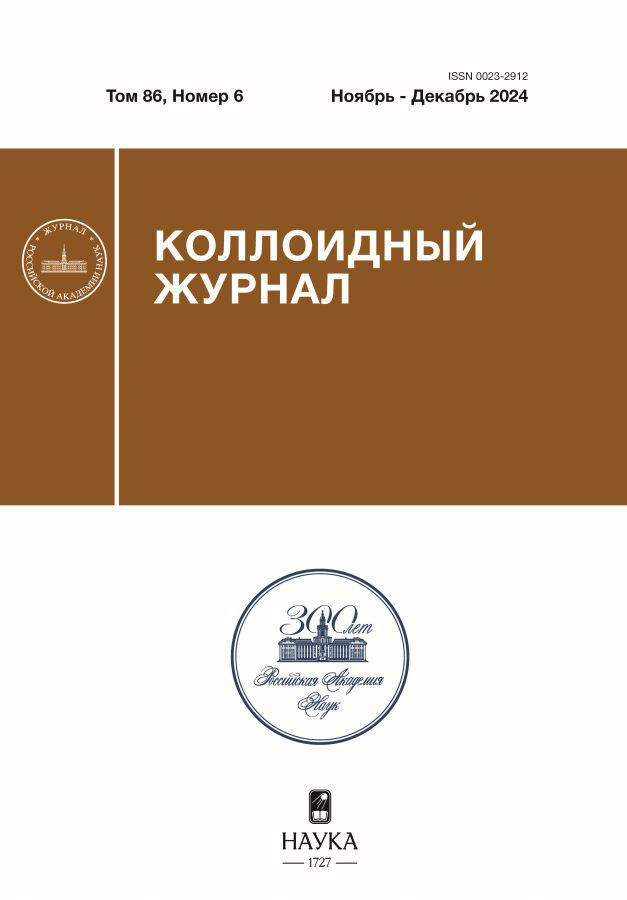Deposition of submicron aerosols in filters from fibers coated with layers of nanowhiskers
- Autores: Kirsh V.A.1
-
Afiliações:
- Институт физической химии и электрохимии им. А.Н. Фрумкина РАН
- Edição: Volume 86, Nº 6 (2024)
- Páginas: 756-765
- Seção: Articles
- ##submission.dateSubmitted##: 29.05.2025
- ##submission.datePublished##: 15.12.2024
- URL: https://rjdentistry.com/0023-2912/article/view/681015
- DOI: https://doi.org/10.31857/S0023291224060089
- EDN: https://elibrary.ru/VLGAJL
- ID: 681015
Citar
Texto integral
Resumo
The deposition of submicron aerosol particles in model filters consisting of micron fibers with radial nanowhiskers on the fiber surface is considered. Numerical modeling of a 3D Stokes transverse flow field was performed in a model filter – an isolated row of parallel fibers with whiskers, taking into account a gas slip effect on their surface. The dependencies of the fiber drag force and the fiber collection efficiency on the length and packing density of the whiskers and on the distance between the fibers are calculated. The dependence of the fiber collection efficiency on the particle radius was determined.
Palavras-chave
Texto integral
Sobre autores
V. Kirsh
Институт физической химии и электрохимии им. А.Н. Фрумкина РАН
Autor responsável pela correspondência
Email: va_kirsch@mail.ru
Rússia, Ленинский проспект, 31, корп. 4, Москва, 119071
Bibliografia
- Davies C.N. Air filtration. N.Y.: Academic Press, 1973.
- Pfefferkorn, G. Elektronenmikroskopische untersuchungen über den oxydationsvorgang von metallen. Naturwissenschaften. 1953. 40. Bd. 551–552. Electron microscopic observations of aerosols (in German). Proc. Aerosol Technology Workshop, Physical Institute of the University of Mainz, Sept. 29. 1954.pp. 599–603. https://doi.org/10.1007/BF00639678
- Brewer J.M., Goren S.L. Evaluation of metal oxide whiskers grown on screens for use as aerosol filtration media // Aerosol Sci. Technol. 1984. V. 3. № 4. P. 411–429. https://doi.org/10.1080/02786828408959029
- Li P., Wang C., Zhang Y., Wei F. Air filtration in the free molecular flow regime: a review of high-efficiency particulate air filters based on carbon nanotubes // SMALL. 2014. V. 10. № 22. P. 4543–4561. https://doi.org/10.1002/smll.201401553
- Zhang R., Wei F. High-efficiency particulate air filters based on carbon nanotubes // Ch. 26 in Nanotube Superfiber Materials. Science, Manufacturing, Commercialization. Micro and Nano Technologies, 2-nd Ed. 2019. P. 643–666. https://doi.org/10.1016/B978-0-12-812667-7.00026-4
- Karwa A.N., Tatarchuk B.J. Aerosol filtration enhancement using carbon nanostructures synthesized within a sintered nickel microfibrous matrix // Sep. Purif. Technol. 2012. V. 87. P. 84–94. https://doi.org/10.1016/j.seppur.2011.11.026
- Park S.J., Lee D.G. Performance improvement of micron-sized fibrous metal filters by direct growth of carbon nanotubes // Carbon. 2006. V. 44. P. 1930–1935. https://doi.org/10.1016/j.carbon.2006.02.005
- Кирш В.А. Аэрозольные фильтры из пористых волокон // Коллоид. журн. 1996. Т. 58. № 6. С. 786–790.
- Кирш А.А., Кирш В.А. Улавливание аэрозольных частиц фильтрами из волокон, покрытых слоями вискеров // Коллоидный журн. 2019. Т. 81. № 6. С. 706–716. https://doi.org/10.1134/S1061933X19060073
- Кирш В.А., Кирш А.А. Влияние наноиголочек на волокнах и частицах на эффективность фильтрации аэрозолей // Коллоидный журнал. 2021. Т. 83. № 3. С. 293–301. https://doi.org/10.1134/S1061933X2103008X
- Kirsch A.A., Stechkina I.B. The theory of aerosol filtration with fibrous filters // Ch. 4, in Fundamentals of Aerosol Science / Ed. By Shaw D.T. N.Y.: Wiley-Interscience. 1978. P. 165‒256.
- Ландау Л.Д., Лифшиц И.М. Теоретическая физика. Т. 6. Гидродинамика. Изд. 4-е, М.: Наука, 1988.
- Левич В.Г. Физико-химическая гидродинамика. М.: ГИФМЛ, 1959.
- Fuchs N.A. The Mechanics of Aerosols. N.Y.: Dover, 1989.
- Luo H., Pozrikidis C. Effect of surface slip on Stokes flow past a spherical particle in infinite fluid and near a plane wall // J. Eng. Math. 2008. V. 62. P. 1–21. https://doi.org/ 10.1007/s10665-007-9170-6
- Кирш В.А., Кирш А.А. Осаждение аэрозольных наночастиц в сеточных диффузионных батареях // Коллоид. журн. 2020. Т. 82. № 4. С. 432–439.https://doi.org/10.1134/S1061933X20040055
- Miyagi T. Viscous flow at low Reynolds numbers past an infinite row of equal circular cylinders // J. Phys. Soc. Japan. 1958. V. 13. № 5. P. 493–496. https://doi.org/10.1143/JPSJ.13.493
- Keller J.B. Viscous flow through a grating or lattice of cylinders // J. Fluid Mech. 1964. V. 18. P. 94–96. https://doi.org/10.1017/S0022112064000064
- Kirsch A.A., Stechkina I.B., Fuchs N.A. Effect of gas slip on the pressure drop in a system of parallel cylinders at small Reynolds numbers // J. Colloid Interface Sci. 1971. V. 37. P. 458–461. https://doi.org/10.1016/0021-9797(71)90314-6
- Кирш В.А., Кирш А.А. Улавливание субмикронных аэрозольных частиц фильтрами из нановолокон // Коллоид. журн. 2023. Т. 85. № 1. С. 38–46. https://doi.org/10.1134/S1061933X22600476
- Кирш В.А. Инерционное осаждение субмикронных аэрозолей в модельных волокнистых фильтрах из ультратонких волокон // Коллоид. журн. 2023. Т. 85. № 3. С. 307–318. https://doi.org/10.1134/S1061933X23600331
Arquivos suplementares






















